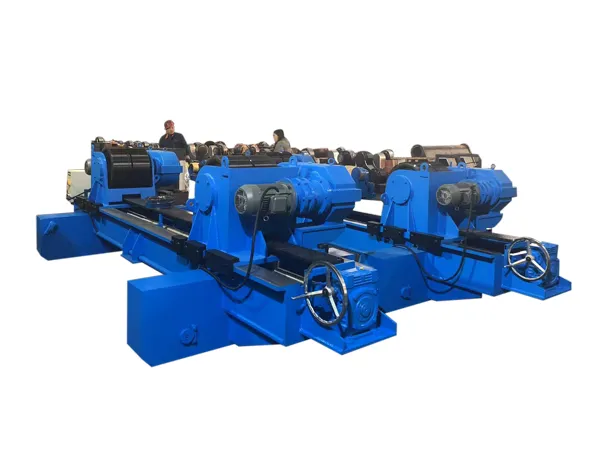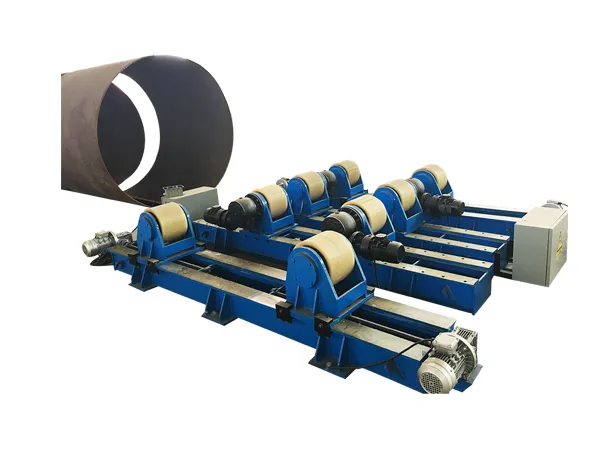Lead screw welding rotators are specialized pieces of equipment designed to support and precisely rotate cylindrical workpieces for welding, polishing, assembly, and other fabrication processes. Their defining feature is the lead screw mechanism, which allows for accurate adjustment of the roller distance to accommodate a wide range of workpiece diameters.
Choosing the right model of lead screw welding rotator is crucial for optimizing your welding operations, ensuring efficiency, quality, and safety.

Weight Capacity: This is the most critical factor. Determine the maximum weight of the cylindrical workpieces (pipes, tanks, vessels, etc.) you will be welding.
Welding rotators are typically rated in tons (e.g., 2T, 5T, 10T, up to hundreds of tons). Ensure the rotator's capacity comfortably exceeds your heaviest workpiece.
Diameter Range: Identify the minimum and maximum diameters of the workpieces you need to rotate. Lead screw rotators offer adjustable roller distances to accommodate various diameters. Make sure the chosen model's adjustment range covers your needs.
Length of Workpiece: For very long workpieces, you might need multiple sets of rotators (one drive unit and multiple idler units) to provide adequate support and
prevent sagging. Consider synchronization features if you plan to use multiple units.
Material of Workpiece: While most rotators are designed for general metals, consider if your material has specific requirements (e.g., very thin walls, sensitive surfaces that might need specialized roller coatings).
Lead Screw Adjustable (Manual or Motorized): This is the defining characteristic. The lead screw mechanism allows for precise adjustment of the roller distance to accommodate different workpiece diameters.
Manual Lead Screw: More economical, suitable for workshops with less frequent changes in workpiece diameter or when precise manual positioning is acceptable.
Motorized Lead Screw: Offers quicker and more precise adjustment, ideal for dynamic fabrication environments with frequent changes in workpiece sizes, reducing setup time and enhancing efficiency.
Self-Centering vs. Conventional (within Lead Screw Type):
Self-Centering Lead Screw Rotators: These are an enhanced version where the lead screw mechanism automatically centers the workpiece by moving both roller brackets equally in opposite directions. This is highly beneficial for varying diameters and frequent job changes, saving significant setup time and improving alignment accuracy.
Conventional Lead Screw Rotators: While still using a lead screw for adjustment, they might require more manual intervention for precise centering.
Rotation Speed Range: The rotator should offer a variable speed drive (VFD - Variable Frequency Drive) to allow for precise control of the rotation speed. This is crucial for different welding processes (TIG, MIG, SAW) and material thicknesses. Look for models that display linear velocity for greater control.
Roller Material:
Polyurethane (PU) or Rubber Coated Rollers: Ideal for finished surfaces, thin-walled vessels, or materials prone to damage, as they provide good friction and prevent scratches.
Steel Rollers: Suitable for heavy-duty applications, high temperatures, or when surface marking is not a concern.
Control System:
Wired Remote Control: Standard for most rotators, offering basic control over start, stop, and speed.
Wireless Remote Control: Provides greater flexibility and safety, allowing the operator to control the rotator from a distance.
Integration with Automation Systems: If you plan to integrate the rotator into an automated welding cell (e.g., with a column and boom manipulator), ensure it has the necessary interfaces and synchronization capabilities.
Foot Switch Control: Useful for hands-free operation during welding.
Synchronization: If using multiple drive units for long workpieces, ensure they have a synchronized rotation system to maintain consistent speed and prevent workpiece distortion or slippage.
Robust Construction: Look for heavy-duty, fabricated steel frames designed to withstand high loads and continuous operation.
Component Quality: Check for reputable brands for motors, gearboxes, electrical components (e.g., Siemens, Schneider). High-quality components ensure reliability and longevity.
Lead Screw Quality: The lead screw itself should be robust and precisely machined to ensure smooth, accurate, and long-lasting adjustment. Consider if the manufacturer specifies rolled thread vs. ground thread lead screws and their respective advantages/disadvantages (precision vs. cost).
Safety Features: Ensure the rotator includes essential safety features like emergency stop buttons, interlocks, and adequate guarding to protect operators.
Roller Bearing Quality: High-precision bearings are essential for stable rotation and long service life.
Portability (with or without rail travel): Some rotators can be designed to move along rails, which is beneficial for very long workpieces or flexible workshop layouts.
Anti-Drift System: For large or heavy workpieces, an anti-drift system helps prevent the workpiece from moving axially during rotation, ensuring consistent weld quality.
Lubrication System: A well-designed lubrication system for moving parts (especially the lead screw and bearings) is crucial for extending the lifespan of the equipment.
OEM Service/Customization: If your workpieces have unique dimensions or requirements, ensure the manufacturer offers customization options.
After-Sales Support and Warranty: Check the manufacturer's warranty period and their availability for technical support, spare parts, and service.

List your specific workpiece requirements: Max/Min weight, max/min diameter, typical length, material type.
Determine your operational needs: How frequently will you change workpiece sizes? Do you need high precision or high volume?
Set your budget: This will help narrow down options, but prioritize essential features over cost savings for long-term productivity.
Research manufacturers: Look for reputable suppliers with a proven track record in welding automation equipment.
Request quotes and specifications: Compare different models from various manufacturers based on your identified needs.
Ask for demonstrations or references: If possible, see the equipment in action or speak to other users.
Consider long-term costs: Factor in maintenance, spare parts availability, and potential downtime.
By carefully evaluating these factors, you can select a Lead Screw Welding Rotator model that perfectly matches your welding needs and contributes to increased productivity and weld quality.
No. 1 Intersection of Chuangye Avenue and Weilai Avenue,
Yiyang County,Luoyang City, Henan Province, China
+86 400-0379-069
Copyright © 2023 An Automated Welding and Cutting Equipment Manufacturer Focusing on Welding Column Boom and Welding Rotator | All Rights Reserved Technical support: ShangXian